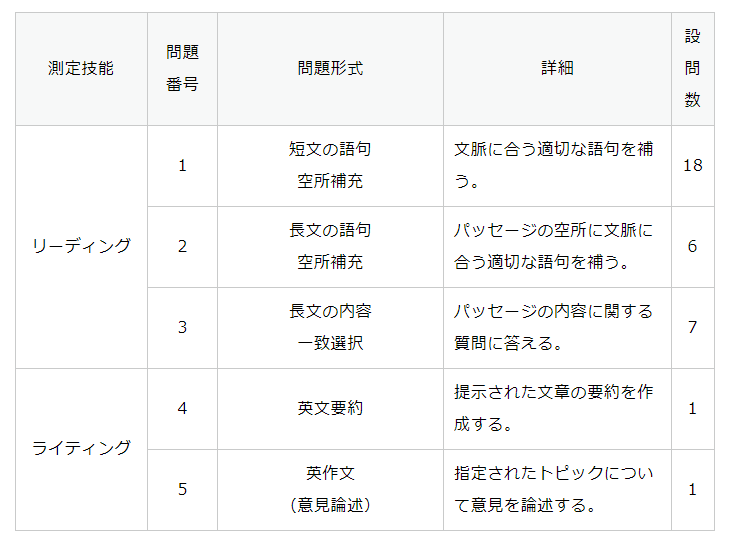
2024年度第1回から英検準1級がリニューアルされます。以下、英検サイトより問題形式や設問数をチェックしてみましょう。
●筆記試験

●リスニングテスト

さて、この表を頭に入れ、さっそく英検準1級の効果的な解き方や時間配分を考えていきましょう!!まずは、英検準1級の各設問ごとの時間配分のポイントです。
★ 全体の配分の目安:
– リーディング・ライティング (33問): 90分
– リスニング: 30分
★ リーディング・ライティングの配分の目安:
– 短文空所補充 (18問): 10分
– 長文空所補充 (6問): 15分
– 長文の内容一致問題 (7問): 20分
– ライティング (2問): 40分※
– 見直し: 5分
– リスニングの先読み: 上記の目安で余った時間
※【新形式のライティング問題の時間配分】
英検準1級の新形式では、ライティングの問題が2題出題されます。
1. 意見論述問題
– 従来からある問題形式で、指定されたトピックについて自分の意見を論理的に述べる必要があります。
– 推奨時間は25分程度です。
2. 要約問題
– 新たに追加された問題形式です。与えられた英文(約200語程度)を60-70語に要約する必要があります。
– 推奨時間は15分程度と考えられています。
つまり、ライティング全体で40分程度が目安となります。意見論述25分、要約15分という時間配分が適切でしょう。
要約問題では以下の4点が評価されるため、時間内に的確な要約ができるよう練習が重要です。
① 内容 – 英文の要点を適切に捉えているか
② 構成 – 論理的に文章を構築できているか
③ 語彙・文法 – 適切な語彙・文法を用いているか
④ 表現 – 文の構造や語句の言い換えに工夫があるか
英検準1級のライティングでは、意見論述25分、要約15分の時間配分が推奨されています。要約問題に十分な時間を割き、内容・構成・語彙・表現の4点を意識して取り組む必要があります。
★ おすすめの解答順:
1) ライティング: 配点も高く、合否に大きく影響するため十分な時間を確保!
2) 短文空所補充
3) 長文空所補充
4) 長文の内容一致問題
5) 見直し
★ 時間配分のコツ:
– わからない問題はとりあえず飛ばして後で戻って考える
– ライティングは最初に構成を考え、数文ごとに再度チェックをする
– リスニングの選択肢は先読みしておく
★ 時間内に解くための勉強法:
– 過去問で、セクションごとにかかった時間を計測、記録する。(学習タイマーを購入し、上の時間配分めやすにタイマーを合わせて解く)
– パス単を購入し、単語力を強化して問題を素早く理解できるようにする
☆おすすめの学習タイマーはドリテックのラーニングタイマー!
T-587ラーニングタイマー – 株式会社ドリテック (dretec.co.jp)
試しに問題を解いてみよう!
リーディングの長文空所補充問題(予想問題)に挑戦しましょう!英検準1級の新しい形式では、大問2は2題出題されます。目安時間は2題で15分ですので、今回は制限時間を7.5分に設定しましょう!
The Mystery of the Moai
The moai are enormous stone statues found on Easter Island, a remote volcanic island in the southeastern Pacific Ocean. The island, also known as Rapa Nui, is famous for these monolithic human figures, which were carved by the Rapa Nui people between the 13th and 16th centuries. The moai are believed to represent the ancestors of the Rapa Nui and were erected on massive stone platforms called ahu, which ( 1 ). The process of creating and transporting these massive statues, some weighing over 80 tons, remains a mystery to this day.
Researchers have proposed various theories about how the Rapa Nui people transported the moai from the quarry where they were carved to their final locations on the island. One theory suggests that the statues were “walked” to their destinations by rocking them back and forth, while another proposes that they were rolled on logs. However, the exact method used ( 2 ), as the Rapa Nui left no written records of their techniques.
Recent studies have also shed light on the possible reasons behind the decline of the Rapa Nui civilization. Some researchers believe that the construction of the moai and ahu ( 3 ), leading to deforestation, soil erosion, and a scarcity of resources. This environmental degradation, combined with other factors such as overpopulation and internal conflicts, may have contributed to the collapse of the Rapa Nui society.
(1)
1 are scattered throughout the island
2 were used for religious ceremonies
3 have been restored by modern archaeologists
4 were built using advanced technology
(2)
1 remains a topic of debate among scholars
2 has been conclusively proven by archaeologists
3 was likely similar to techniques used in other ancient civilizations
4 is no longer of interest to researchers
(3)
1 required significant labor and resources
2 had no impact on the island’s environment
3 was a sustainable practice
4 helped preserve the island’s natural resources
【解答】
(1) ahu(アフ)は宗教的な儀式に使用されたと考えられているため、2が正解です。
(2) モアイがどのように運ばれたのかについては、研究者の間でまだ議論が続いています。ラパ・ヌイ人が書き残した記録がないため、1が正解です。
(3) モアイとアフの建設には多大な労力と資源が必要だったと考えられています。その結果、森林伐採や土壌浸食などの環境悪化を引き起こした可能性があるため、1が正解です。
【音読用スクリプト】
The Mystery of the Moai
The moai are enormous stone statues found on Easter Island, a remote volcanic island in the southeastern Pacific Ocean. The island, also known as Rapa Nui, is famous for these monolithic human figures, which were carved by the Rapa Nui people between the 13th and 16th centuries. The moai are believed to represent the ancestors of the Rapa Nui and were erected on massive stone platforms called ahu, which were used for religious ceremonies. The process of creating and transporting these massive statues, some weighing over 80 tons, remains a mystery to this day.
Researchers have proposed various theories about how the Rapa Nui people transported the moai from the quarry where they were carved to their final locations on the island. One theory suggests that the statues were “walked” to their destinations by rocking them back and forth, while another proposes that they were rolled on logs. However, the exact method used remains a topic of debate among scholars, as the Rapa Nui left no written records of their techniques.
Recent studies have also shed light on the possible reasons behind the decline of the Rapa Nui civilization. Some researchers believe that the construction of the moai and ahu required significant labor and resources, leading to deforestation, soil erosion, and a scarcity of resources. This environmental degradation, combined with other factors such as overpopulation and internal conflicts, may have contributed to the collapse of the Rapa Nui society.
【訳】
モアイの謎
モアイは、南東太平洋の人里離れた火山島であるイースター島に存在する巨大な石像です。ラパ・ヌイとしても知られるこの島は、13世紀から16世紀の間にラパ・ヌイ人によって彫られたこれらの一枚岩の人型像で有名です。モアイはラパ・ヌイ人の祖先を表していると考えられており、アフと呼ばれる巨大な石の台座の上に建てられました。アフは宗教的な儀式に使用されていました。重さが80トンを超えるものもあるこれらの巨大な像を作成し、運搬するプロセスは、今日でも謎のままです。
研究者たちは、ラパ・ヌイ人がモアイを彫った採石場から島の最終的な位置まで、どのようにして運んだのかについて、様々な理論を提唱しています。一つの理論では、像を前後に揺らしながら「歩かせて」目的地まで運んだと示唆されています。一方、別の理論では、丸太の上で転がして運んだと提案されています。しかし、ラパ・ヌイ人が技術についての記録を残していないため、実際に使用された方法は学者の間で議論の的となっています。
最近の研究では、ラパ・ヌイ文明の衰退の背後にある可能性のある理由についても明らかにされています。一部の研究者は、モアイとアフの建設には多大な労力と資源が必要であり、森林伐採、土壌浸食、資源の不足につながったと考えています。この環境悪化は、人口過剰や内部紛争などの他の要因と相まって、ラパ・ヌイ社会の崩壊に寄与した可能性があります。

